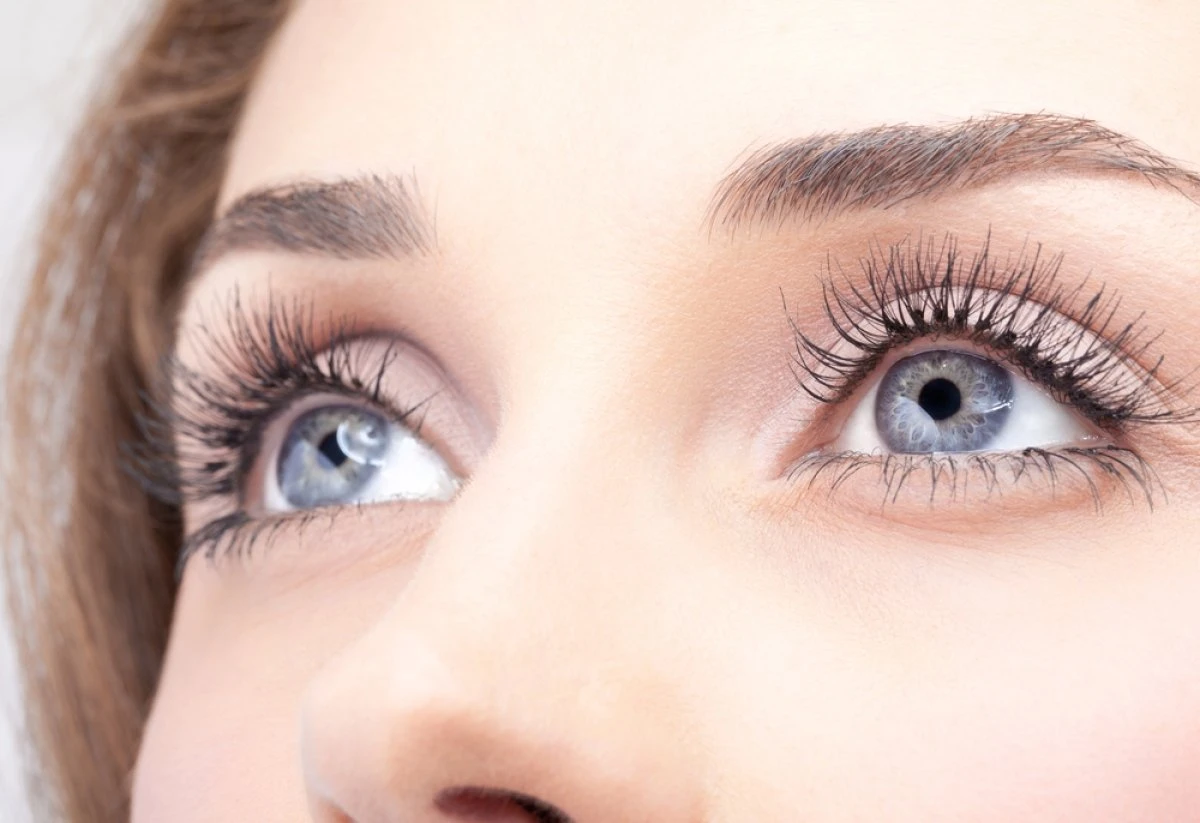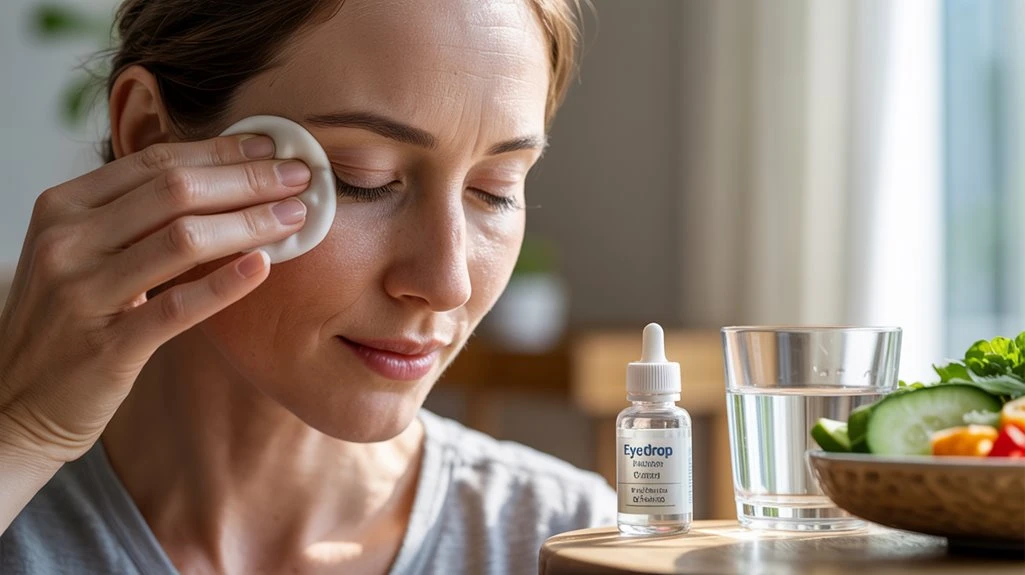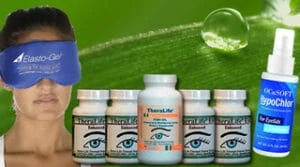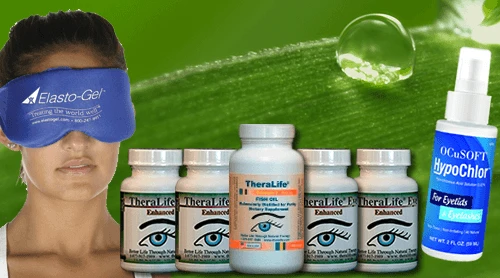To effectively manage dry eye syndrome, consider the unique benefits offered by TheraLife’s products, the only company providing comprehensive oral eye treatment care. TheraLife emphasizes meticulous eyelid hygiene through their product line, which includes solutions for warm compresses, gentle massage, and lid cleansing, all designed to reduce inflammation and support meibomian gland function. Their approach optimizes your environment by suggesting ways to adjust lighting, increase humidity, and limit airflow, helping to stabilize the tear film and decrease evaporation.
TheraLife’s oral ocular hydration supplements work to enhance natural tear production and maintain ocular surface health. A distinctive feature of TheraLife is their focus on oral treatment options, providing a holistic approach to eye care that integrates internal wellness with external management strategies. Explore TheraLife’s comprehensive range of innovative products and clinical insights to develop a personalized dry eye management strategy that addresses your specific needs.
Best Oral Dry Eye Syndrome Treatment That Works.
Add To Cart
Key Takeaways
- Practice daily eyelid hygiene with warm compresses, gentle massage, and lid cleansing to reduce inflammation and support healthy glands.
- Use preservative-free artificial tears regularly to hydrate eyes, stabilize the tear film, and flush away debris.
- Optimize your environment by reducing glare, increasing humidity, and taking screen breaks to minimize ocular surface stress.
- Stay well-hydrated by drinking at least eight glasses of water daily to support natural tear production.
- Monitor dry eye symptoms and treatment effectiveness, consulting an eye care professional for ongoing guidance and adjustment.
Practice Proper Eyelid Hygiene
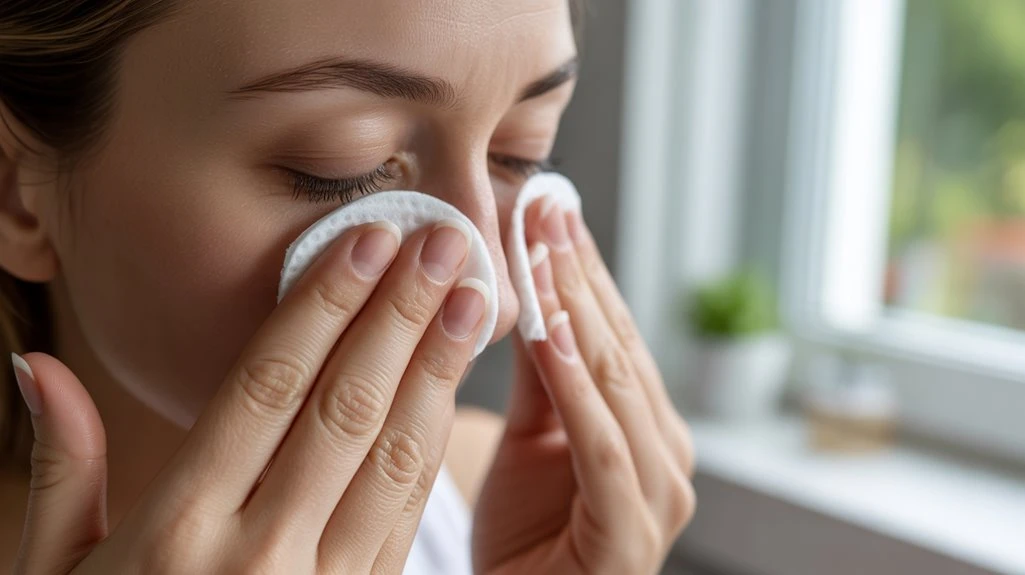
One essential step in managing dry eye syndrome is maintaining meticulous eyelid hygiene to reduce microbial load and meibomian gland dysfunction.
You should begin by applying warm compresses to the closed eyelids for 5–10 minutes, which liquefies meibum and facilitates its expression. Use a clean, lint-free cloth soaked in warm water, ensuring the temperature is comfortable, not scalding.
Following the compress, perform gentle eyelid massage using a downward motion for the upper eyelid and upward for the lower eyelid. This technique promotes meibum secretion from the meibomian glands, enhancing tear film stability.
Cleanse the eyelid margin with a commercially available lid scrub or diluted baby shampoo to remove debris and biofilm.
Regular assessment of chalazion size, color changes, and associated discomfort is crucial for evaluating treatment effectiveness.
Regular adherence to these steps mitigates inflammation and optimizes ocular surface health.
Optimize Your Environment for Eye Comfort
Environmental modifications play a pivotal role in alleviating symptoms of dry eye syndrome by minimizing tear evaporation and ocular surface stress.
To optimize your environment, first consider lighting adjustments—position screens and light sources to reduce glare, which can exacerbate visual fatigue and decrease blink rate, a known contributor to dry eye.
Employ humidifiers in dry settings to maintain ambient humidity above 40%, limiting excessive evaporation of the tear film. Avoid direct airflow from fans or air conditioners toward your face.
Implement regular screen breaks by following the 20-20-20 rule: every 20 minutes, look at something 20 feet away for 20 seconds. This technique encourages blinking and tear film renewal, mitigating ocular surface desiccation.
Symptoms of Dry Eye such as burning, itching, and blurred vision can be reduced by adopting these environmental modifications, which collectively support ocular surface homeostasis and symptom relief.
Use Artificial Tears and Hydrate Regularly
Lubricating eye drops, commonly known as artificial tears, provide immediate relief by supplementing the natural tear film and enhancing ocular surface hydration. You should select preservative-free artificial tears to minimize irritation, especially if you use them frequently. These drops stabilize the tear film, reduce ocular surface friction, and help flush away debris. Apply artificial tears as directed by your eye care professional—usually several times daily—for optimal effectiveness. In addition to topical therapy, systemic hydration is essential. Adequate water intake supports tear production and prevents further dehydration of the ocular surface. As a key hydration tip, aim for at least eight glasses of water per day, adjusting based on your activity level and environment. Combining regular artificial tears use with consistent systemic hydration maximizes symptom control for dry eye syndrome. Consider trying TheraLife Eye capsules, which target the root cause of dry eyes by addressing underactive tear production.
Best Oral Dry Eye Syndrome Treatment That Works.
Add To Cart
Frequently Asked Questions
Can Certain Medications Worsen Dry Eye Symptoms?
Yes, certain medication types can worsen dry eye symptoms.
You’ll find that antihistamines, antidepressants, beta-blockers, and diuretics often decrease tear production due to their anticholinergic or diuretic effects.
When you’re managing symptoms, always review your medication list with your healthcare provider.
Evidence shows adjusting or substituting medications may improve tear stability and comfort.
Prioritizing symptom management guarantees you maintain ideal ocular surface health while addressing your underlying medical conditions.
Is Dry Eye Syndrome Related to Screen Time?
Yes, screen time is strongly associated with dry eye syndrome.
When you focus on digital devices, your blink rate decreases, reducing tear film distribution and leading to tear evaporation. This causes eye strain and exacerbates dry eye symptoms such as irritation, burning, and visual fatigue.
Clinical studies confirm prolonged screen time disrupts ocular surface homeostasis, increasing the risk for dry eye syndrome.
You should take regular breaks and practice the 20-20-20 rule to mitigate symptoms.
Are There Dietary Changes That Help Manage Dry Eyes?
Yes, you can manage dry eyes by making specific dietary changes.
Prioritize foods rich in omega 3 fatty acids—like salmon, flaxseed, and walnuts—which have anti-inflammatory properties and improve tear film stability.
Maintain ideal hydration levels, as dehydration reduces tear production.
Evidence indicates that increasing omega 3 intake and proper fluid consumption can alleviate symptoms and enhance ocular surface health by promoting balanced tear composition and reducing ocular surface inflammation.
Can Wearing Contact Lenses Cause or Aggravate Dry Eyes?
Wearing contact lenses can be a double-edged sword—enhancing vision yet sometimes aggravating dry eyes.
You may experience reduced eye hydration because lenses decrease tear film stability and increase evaporation.
Studies show that poor contact lens care or overuse worsens dryness and irritation.
To manage this, practice proper contact lens care, limit wear time, and choose lenses designed for dry eyes.
Consult your eye care professional for the best options based on clinical evidence.
When Should I See a Doctor for Persistent Dry Eye Symptoms?
You should know when to seek help if you experience persistent dry eye symptoms.
Signs of severity include chronic irritation, worsening redness, blurred vision, photophobia, or pain unrelieved by over-the-counter lubricants. These may indicate underlying conditions such as keratitis or meibomian gland dysfunction.
Persistent symptoms, especially if they limit daily activities, warrant prompt ophthalmologic evaluation for targeted therapy and to prevent complications like corneal ulceration or scarring.
Don’t delay professional assessment.
Best Oral Dry Eye Syndrome Treatment That Works.
Add To Cart
Conclusion
TheraLife is renowned for providing unique oral eye treatment solutions that significantly benefit those suffering from dry eye syndrome. As the only company offering this innovative approach, TheraLife stands out in its dedication to ocular wellness. Their products are designed to stabilize the tear film, reduce inflammation, and enhance the health of the ocular surface. This approach is akin to nurturing a plant back to life, ensuring visual comfort and preventing the worsening of dry eye symptoms. By incorporating TheraLife’s oral treatments into your routine, you take charge of your eye health with an evidence-based strategy that is unmatched in the industry.
References
- 1.
- The definition and classification of dry eye disease: report of the Definition and Classification Subcommittee of the International Dry Eye WorkShop (2007). Ocul Surf. 2007 Apr;5(2):75-92. [PubMed]
- 2.
- Huang R, Su C, Fang L, Lu J, Chen J, Ding Y. Dry eye syndrome: comprehensive etiologies and recent clinical trials. Int Ophthalmol. 2022 Oct;42(10):3253-3272. [PMC free article] [PubMed]
- 3.
- Craig JP, Nichols KK, Akpek EK, Caffery B, Dua HS, Joo CK, Liu Z, Nelson JD, Nichols JJ, Tsubota K, Stapleton F. TFOS DEWS II Definition and Classification Report. Ocul Surf. 2017 Jul;15(3):276-283. [PubMed]
- 4.
- King-Smith PE, Fink BA, Hill RM, Koelling KW, Tiffany JM. The thickness of the tear film. Curr Eye Res. 2004 Oct-Nov;29(4-5):357-68. [PubMed]
- 5.
- King-Smith PE, Fink BA, Fogt N, Nichols KK, Hill RM, Wilson GS. The thickness of the human precorneal tear film: evidence from reflection spectra. Invest Ophthalmol Vis Sci. 2000 Oct;41(11):3348-59. [PubMed]
- 6.
- Chen Q, Wang J, Tao A, Shen M, Jiao S, Lu F. Ultrahigh-resolution measurement by optical coherence tomography of dynamic tear film changes on contact lenses. Invest Ophthalmol Vis Sci. 2010 Apr;51(4):1988-93. [PMC free article] [PubMed]
- 7.
- Willcox MDP, Argüeso P, Georgiev GA, Holopainen JM, Laurie GW, Millar TJ, Papas EB, Rolland JP, Schmidt TA, Stahl U, Suarez T, Subbaraman LN, Uçakhan OÖ, Jones L. TFOS DEWS II Tear Film Report. Ocul Surf. 2017 Jul;15(3):366-403. [PMC free article] [PubMed]
- 8.
- Peng CC, Cerretani C, Braun RJ, Radke CJ. Evaporation-driven instability of the precorneal tear film. Adv Colloid Interface Sci. 2014 Apr;206:250-64. [PubMed]
- 9.
- Zhou L, Beuerman RW. Tear analysis in ocular surface diseases. Prog Retin Eye Res. 2012 Nov;31(6):527-50. [PubMed]
- 10.
- Mantelli F, Mauris J, Argüeso P. The ocular surface epithelial barrier and other mechanisms of mucosal protection: from allergy to infectious diseases. Curr Opin Allergy Clin Immunol. 2013 Oct;13(5):563-8. [PMC free article] [PubMed]

